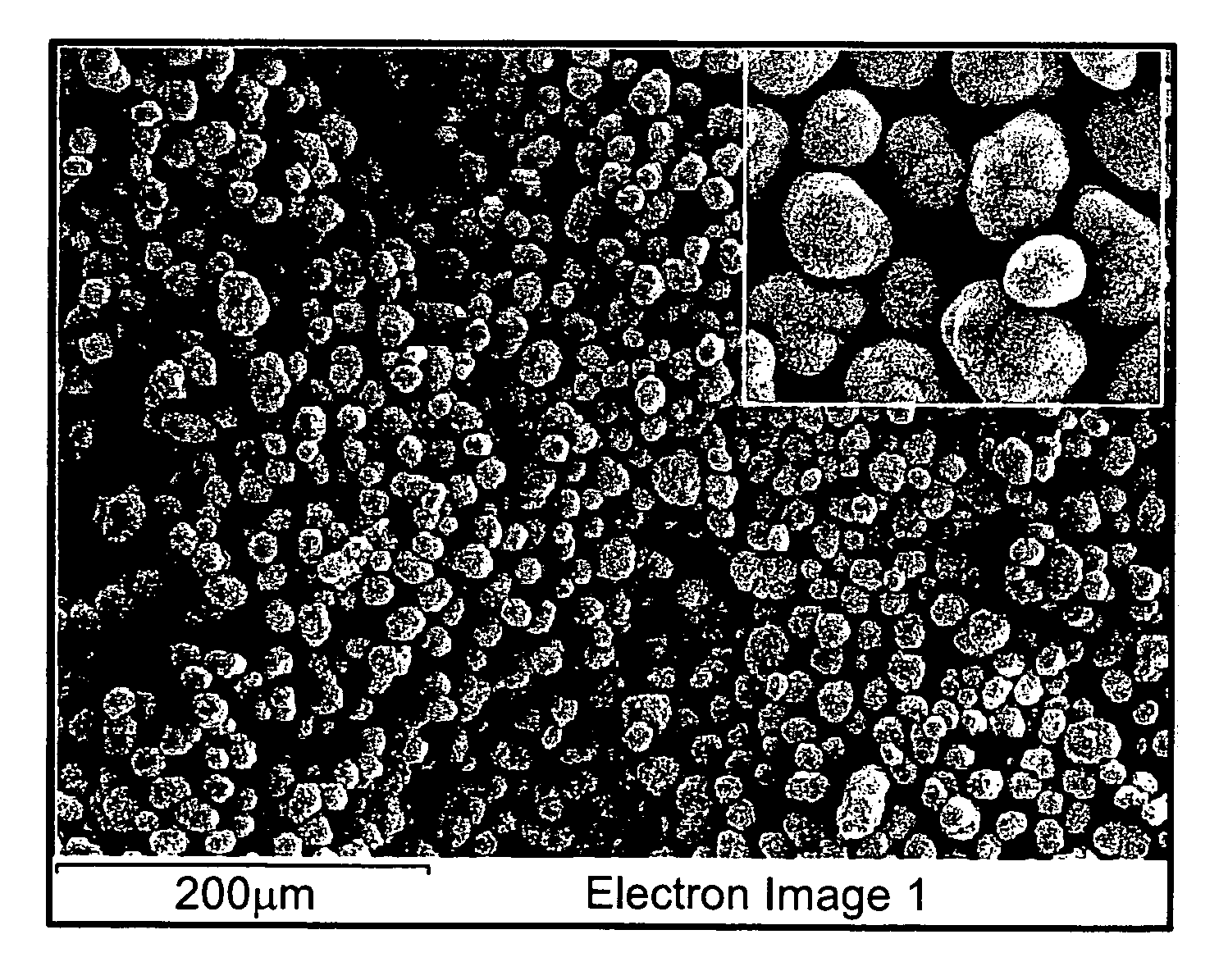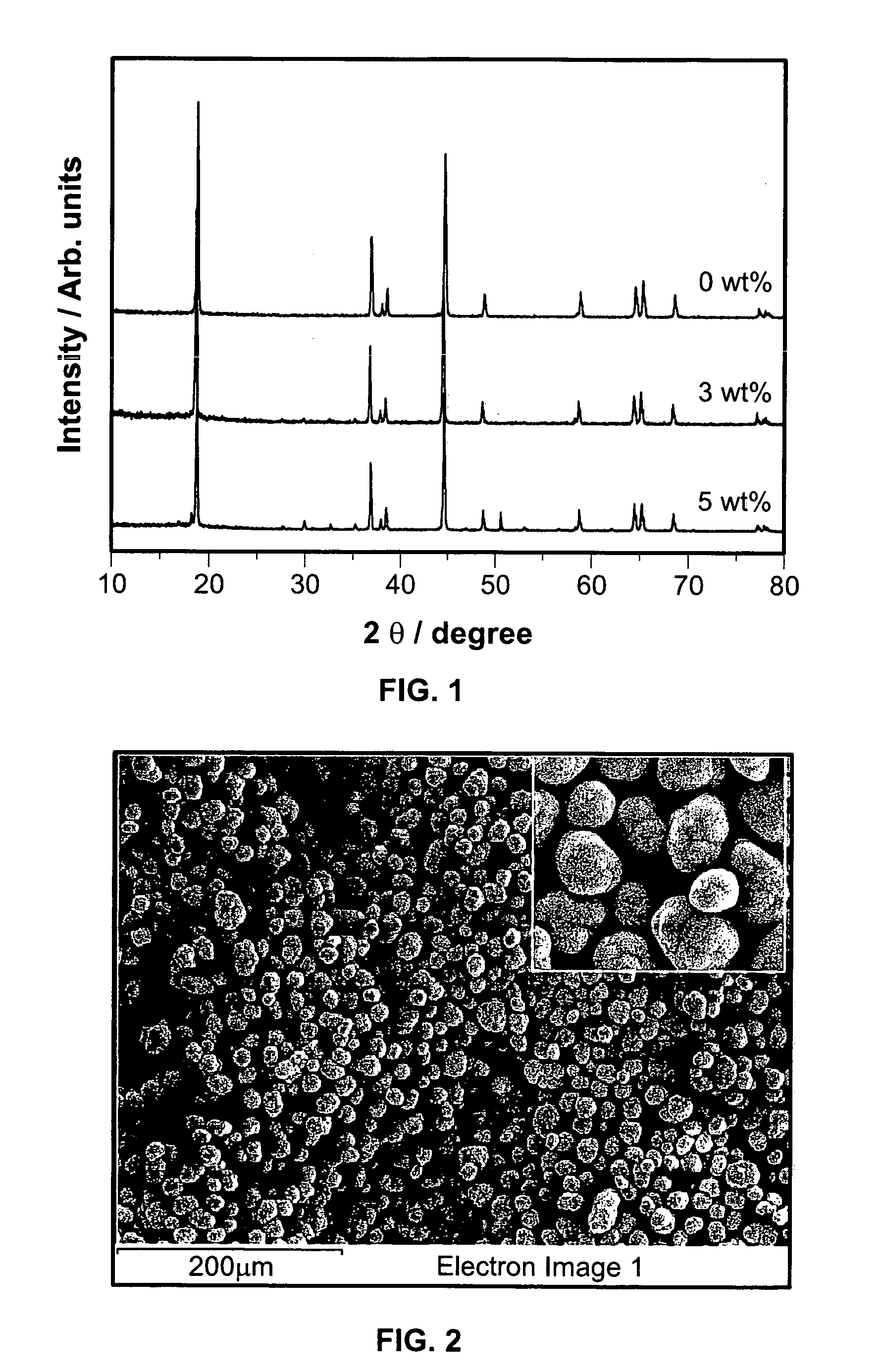Cathode material for lithium batteries
a lithium battery and cathode material technology, applied in the direction of cell components, electrochemical generators, nickel compounds, etc., can solve the problems of poor thermal stability, low specific energy density, and inability to readily obtain cobalt raw materials, etc., to achieve excellent cycle life performance, high specific energy density, and high tap density
- Summary
- Abstract
- Description
- Claims
- Application Information
AI Technical Summary
Benefits of technology
Problems solved by technology
Method used
Image
Examples
example 1
[0026]Nickel-cobalt-manganese carbonate (Ni1 / 3Co1 / 3Mn1 / 3CO3) is prepared by a carbonate co-precipitation method, as follows; An aqueous solution of NiSO4, CoSO4, and MnSO4 (cationic ratio of Ni:Co:Mn=1:1:1) with a concentration of 2.0 mol dm−3 is pumped into a continuous stirred tank reactor (CSTR, capacity 4 L) under a CO2 atmosphere. At the same time, Na2CO3 solution (aq.) of 2.0 mol dm−3 and a desired amount of NH4OH solution (aq.) are also separately fed into the reactor. The solution is maintained at 50° C. for 12 h while closely monitoring the concentration of the solution (2M), pH7.5, temperature (50° C.), and stirring speed (1000 rpm) of the mixture. Then, the spherical (Ni1 / 3Co1 / 3Mn1 / 3)CO3 powder formed is filtered, washed, and vacuum-dried at room temperature. Next the-prepared spherical (Ni1 / 3Co1 / 3Mn1 / 3)CO3 powder is dried at 100° C. to remove the adsorbed water. Next, the carbonate powder is fired at 600° C. for 5 hours to decompose the carbonate, and to obtain an interm...
example 2
[0029]The procedure of Example 1 was repeated, except that the added amounts of MoO3 was 10 wt % (weight ratio was Li(Ni1 / 3Co1 / 3Mn1 / 3)O2:MoO3=1:0.1). The results of the evaluations are shown in Table 1.
TABLE 1LatticeTapconstantCapacityEnergywt % of addedCalcinationdensityÅmAh / gdensityNo.MoO3conditiong / mlacinitial50thmAh / mlEx. 15900° C.-2.132.8614.1715414732420 hrEx. 210900° C.-2.322.8614.2014213732820 hrEx. 315900° C.-2.332.8614.2011010332520 hrEx. 43900° C.-2.132.8614.171541423280.5 hrEx. 55900° C.-2.182.8614.171511393290.5 hrEx. 67900° C.-2.232.8614.181451343230.5 hrEx. 710900° C.-2.282.8614.201301243370.5 hrEx. 85900° C.-2.252.8614.171481413330.5 hrEx. 95900° C.-2.372.8614.171291353050.5 hrEx. 105900° C.-2.272.8614.201481433350.5 hrEx. 110900° C.-1.92.8614.1815014328520 hrComp.0900° C.-1.72.8614.17165155280Ex. 120 hr
example 3
[0030]The procedure of Example 1 was repeated, except that added amounts of MoO3 was 15 wt % (weight ratio was Li(Ni1 / 3Co1 / 3Mn1 / 3)O2:MoO3=1:0.15). The results of evaluations are shown in Table 1.
PUM
| Property | Measurement | Unit |
|---|---|---|
| diameter | aaaaa | aaaaa |
| tap density | aaaaa | aaaaa |
| temperature | aaaaa | aaaaa |
Abstract
Description
Claims
Application Information
 Login to View More
Login to View More - R&D
- Intellectual Property
- Life Sciences
- Materials
- Tech Scout
- Unparalleled Data Quality
- Higher Quality Content
- 60% Fewer Hallucinations
Browse by: Latest US Patents, China's latest patents, Technical Efficacy Thesaurus, Application Domain, Technology Topic, Popular Technical Reports.
© 2025 PatSnap. All rights reserved.Legal|Privacy policy|Modern Slavery Act Transparency Statement|Sitemap|About US| Contact US: help@patsnap.com



